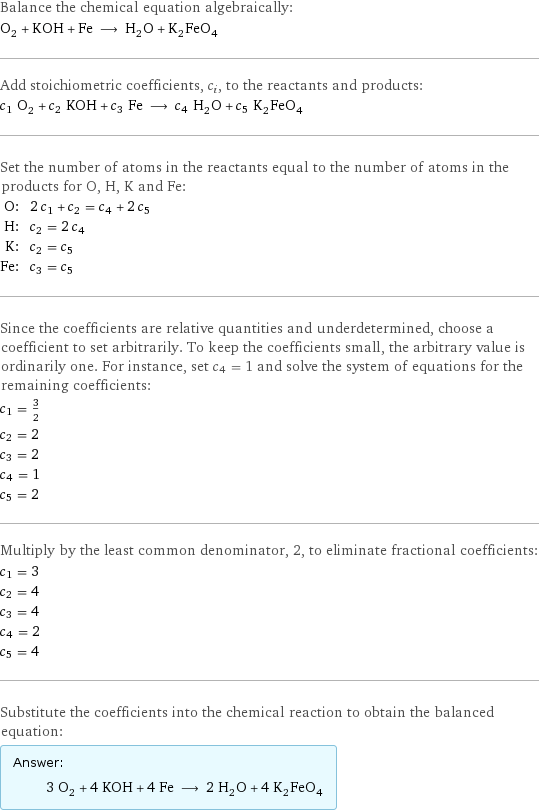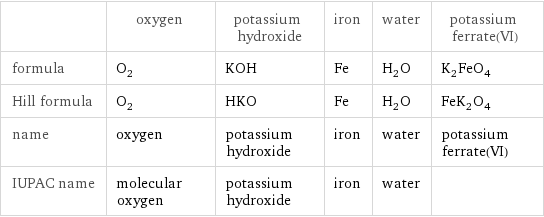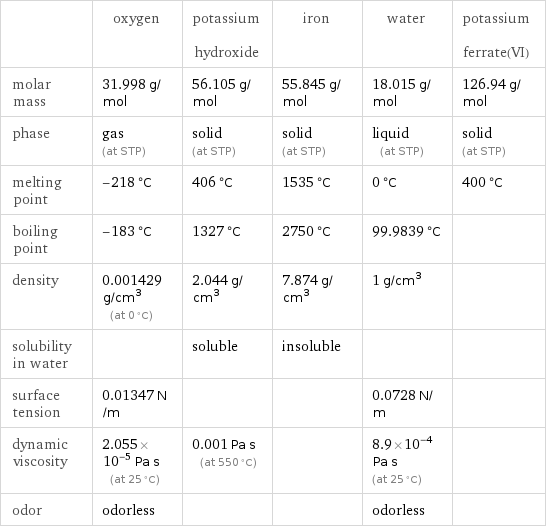Input interpretation

O_2 oxygen + KOH potassium hydroxide + Fe iron ⟶ H_2O water + K_2FeO_4 potassium ferrate(VI)
Balanced equation

Balance the chemical equation algebraically: O_2 + KOH + Fe ⟶ H_2O + K_2FeO_4 Add stoichiometric coefficients, c_i, to the reactants and products: c_1 O_2 + c_2 KOH + c_3 Fe ⟶ c_4 H_2O + c_5 K_2FeO_4 Set the number of atoms in the reactants equal to the number of atoms in the products for O, H, K and Fe: O: | 2 c_1 + c_2 = c_4 + 2 c_5 H: | c_2 = 2 c_4 K: | c_2 = c_5 Fe: | c_3 = c_5 Since the coefficients are relative quantities and underdetermined, choose a coefficient to set arbitrarily. To keep the coefficients small, the arbitrary value is ordinarily one. For instance, set c_4 = 1 and solve the system of equations for the remaining coefficients: c_1 = 3/2 c_2 = 2 c_3 = 2 c_4 = 1 c_5 = 2 Multiply by the least common denominator, 2, to eliminate fractional coefficients: c_1 = 3 c_2 = 4 c_3 = 4 c_4 = 2 c_5 = 4 Substitute the coefficients into the chemical reaction to obtain the balanced equation: Answer: | | 3 O_2 + 4 KOH + 4 Fe ⟶ 2 H_2O + 4 K_2FeO_4
Structures

+ + ⟶ +
Names

oxygen + potassium hydroxide + iron ⟶ water + potassium ferrate(VI)
Equilibrium constant
![Construct the equilibrium constant, K, expression for: O_2 + KOH + Fe ⟶ H_2O + K_2FeO_4 Plan: • Balance the chemical equation. • Determine the stoichiometric numbers. • Assemble the activity expression for each chemical species. • Use the activity expressions to build the equilibrium constant expression. Write the balanced chemical equation: 3 O_2 + 4 KOH + 4 Fe ⟶ 2 H_2O + 4 K_2FeO_4 Assign stoichiometric numbers, ν_i, using the stoichiometric coefficients, c_i, from the balanced chemical equation in the following manner: ν_i = -c_i for reactants and ν_i = c_i for products: chemical species | c_i | ν_i O_2 | 3 | -3 KOH | 4 | -4 Fe | 4 | -4 H_2O | 2 | 2 K_2FeO_4 | 4 | 4 Assemble the activity expressions accounting for the state of matter and ν_i: chemical species | c_i | ν_i | activity expression O_2 | 3 | -3 | ([O2])^(-3) KOH | 4 | -4 | ([KOH])^(-4) Fe | 4 | -4 | ([Fe])^(-4) H_2O | 2 | 2 | ([H2O])^2 K_2FeO_4 | 4 | 4 | ([K2FeO4])^4 The equilibrium constant symbol in the concentration basis is: K_c Mulitply the activity expressions to arrive at the K_c expression: Answer: | | K_c = ([O2])^(-3) ([KOH])^(-4) ([Fe])^(-4) ([H2O])^2 ([K2FeO4])^4 = (([H2O])^2 ([K2FeO4])^4)/(([O2])^3 ([KOH])^4 ([Fe])^4)](../image_source/6c8d529e1c8763ffe548d6074226afac.png)
Construct the equilibrium constant, K, expression for: O_2 + KOH + Fe ⟶ H_2O + K_2FeO_4 Plan: • Balance the chemical equation. • Determine the stoichiometric numbers. • Assemble the activity expression for each chemical species. • Use the activity expressions to build the equilibrium constant expression. Write the balanced chemical equation: 3 O_2 + 4 KOH + 4 Fe ⟶ 2 H_2O + 4 K_2FeO_4 Assign stoichiometric numbers, ν_i, using the stoichiometric coefficients, c_i, from the balanced chemical equation in the following manner: ν_i = -c_i for reactants and ν_i = c_i for products: chemical species | c_i | ν_i O_2 | 3 | -3 KOH | 4 | -4 Fe | 4 | -4 H_2O | 2 | 2 K_2FeO_4 | 4 | 4 Assemble the activity expressions accounting for the state of matter and ν_i: chemical species | c_i | ν_i | activity expression O_2 | 3 | -3 | ([O2])^(-3) KOH | 4 | -4 | ([KOH])^(-4) Fe | 4 | -4 | ([Fe])^(-4) H_2O | 2 | 2 | ([H2O])^2 K_2FeO_4 | 4 | 4 | ([K2FeO4])^4 The equilibrium constant symbol in the concentration basis is: K_c Mulitply the activity expressions to arrive at the K_c expression: Answer: | | K_c = ([O2])^(-3) ([KOH])^(-4) ([Fe])^(-4) ([H2O])^2 ([K2FeO4])^4 = (([H2O])^2 ([K2FeO4])^4)/(([O2])^3 ([KOH])^4 ([Fe])^4)
Rate of reaction
![Construct the rate of reaction expression for: O_2 + KOH + Fe ⟶ H_2O + K_2FeO_4 Plan: • Balance the chemical equation. • Determine the stoichiometric numbers. • Assemble the rate term for each chemical species. • Write the rate of reaction expression. Write the balanced chemical equation: 3 O_2 + 4 KOH + 4 Fe ⟶ 2 H_2O + 4 K_2FeO_4 Assign stoichiometric numbers, ν_i, using the stoichiometric coefficients, c_i, from the balanced chemical equation in the following manner: ν_i = -c_i for reactants and ν_i = c_i for products: chemical species | c_i | ν_i O_2 | 3 | -3 KOH | 4 | -4 Fe | 4 | -4 H_2O | 2 | 2 K_2FeO_4 | 4 | 4 The rate term for each chemical species, B_i, is 1/ν_i(Δ[B_i])/(Δt) where [B_i] is the amount concentration and t is time: chemical species | c_i | ν_i | rate term O_2 | 3 | -3 | -1/3 (Δ[O2])/(Δt) KOH | 4 | -4 | -1/4 (Δ[KOH])/(Δt) Fe | 4 | -4 | -1/4 (Δ[Fe])/(Δt) H_2O | 2 | 2 | 1/2 (Δ[H2O])/(Δt) K_2FeO_4 | 4 | 4 | 1/4 (Δ[K2FeO4])/(Δt) (for infinitesimal rate of change, replace Δ with d) Set the rate terms equal to each other to arrive at the rate expression: Answer: | | rate = -1/3 (Δ[O2])/(Δt) = -1/4 (Δ[KOH])/(Δt) = -1/4 (Δ[Fe])/(Δt) = 1/2 (Δ[H2O])/(Δt) = 1/4 (Δ[K2FeO4])/(Δt) (assuming constant volume and no accumulation of intermediates or side products)](../image_source/d1640adb72addcd14e5aac525e2dd4c9.png)
Construct the rate of reaction expression for: O_2 + KOH + Fe ⟶ H_2O + K_2FeO_4 Plan: • Balance the chemical equation. • Determine the stoichiometric numbers. • Assemble the rate term for each chemical species. • Write the rate of reaction expression. Write the balanced chemical equation: 3 O_2 + 4 KOH + 4 Fe ⟶ 2 H_2O + 4 K_2FeO_4 Assign stoichiometric numbers, ν_i, using the stoichiometric coefficients, c_i, from the balanced chemical equation in the following manner: ν_i = -c_i for reactants and ν_i = c_i for products: chemical species | c_i | ν_i O_2 | 3 | -3 KOH | 4 | -4 Fe | 4 | -4 H_2O | 2 | 2 K_2FeO_4 | 4 | 4 The rate term for each chemical species, B_i, is 1/ν_i(Δ[B_i])/(Δt) where [B_i] is the amount concentration and t is time: chemical species | c_i | ν_i | rate term O_2 | 3 | -3 | -1/3 (Δ[O2])/(Δt) KOH | 4 | -4 | -1/4 (Δ[KOH])/(Δt) Fe | 4 | -4 | -1/4 (Δ[Fe])/(Δt) H_2O | 2 | 2 | 1/2 (Δ[H2O])/(Δt) K_2FeO_4 | 4 | 4 | 1/4 (Δ[K2FeO4])/(Δt) (for infinitesimal rate of change, replace Δ with d) Set the rate terms equal to each other to arrive at the rate expression: Answer: | | rate = -1/3 (Δ[O2])/(Δt) = -1/4 (Δ[KOH])/(Δt) = -1/4 (Δ[Fe])/(Δt) = 1/2 (Δ[H2O])/(Δt) = 1/4 (Δ[K2FeO4])/(Δt) (assuming constant volume and no accumulation of intermediates or side products)
Chemical names and formulas

| oxygen | potassium hydroxide | iron | water | potassium ferrate(VI) formula | O_2 | KOH | Fe | H_2O | K_2FeO_4 Hill formula | O_2 | HKO | Fe | H_2O | FeK_2O_4 name | oxygen | potassium hydroxide | iron | water | potassium ferrate(VI) IUPAC name | molecular oxygen | potassium hydroxide | iron | water |
Substance properties

| oxygen | potassium hydroxide | iron | water | potassium ferrate(VI) molar mass | 31.998 g/mol | 56.105 g/mol | 55.845 g/mol | 18.015 g/mol | 126.94 g/mol phase | gas (at STP) | solid (at STP) | solid (at STP) | liquid (at STP) | solid (at STP) melting point | -218 °C | 406 °C | 1535 °C | 0 °C | 400 °C boiling point | -183 °C | 1327 °C | 2750 °C | 99.9839 °C | density | 0.001429 g/cm^3 (at 0 °C) | 2.044 g/cm^3 | 7.874 g/cm^3 | 1 g/cm^3 | solubility in water | | soluble | insoluble | | surface tension | 0.01347 N/m | | | 0.0728 N/m | dynamic viscosity | 2.055×10^-5 Pa s (at 25 °C) | 0.001 Pa s (at 550 °C) | | 8.9×10^-4 Pa s (at 25 °C) | odor | odorless | | | odorless |
Units
